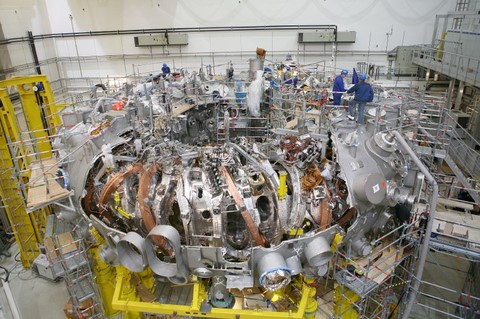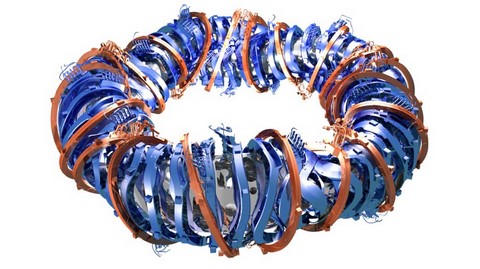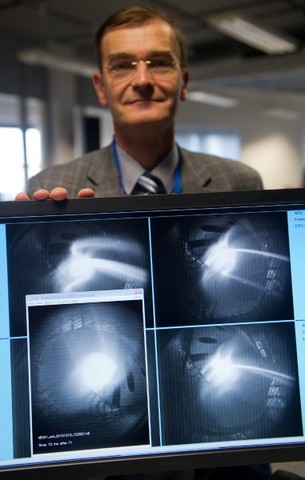The German sun-machine is on
Nuclear fusion installation Wendelstein 7-X at Greifswald, Germany

Over the past year, the fusion installation at Greifswald has being going through its launching process, one step at a time. Last Thursday, December 10th, 2015, it has been turned on. The physicists fed one milligram of helium into the strict vacuum of the 16 meter, 30 cubic meter doughnut, they switched on the microwave heating to give a short 1.8 Megawatt pulse – and were able to observe the result on their cameras: their first plasma.
"We are startig off with a plasma from the rare gas helium,“ explained Thomas Klinger, the scientific director of the experiment. Some time next year, they will move on to the actual object of their research at this stage, hydrogen plasma. “With helium, it is easier to reach the plasma state. Moreover, it allows us to scrub clean the surface of the plasma container with the help of the helium-plasma.”
The Wendelstein 7-X installation which has just been switched on might write scientific history. After all, what scientists are after, here, is a quasi unexhaustible form of energy which up now has proven unusable – nuclear fusion. With a few grams of hydrogen one might be able, at least in theory, to run a large powerplant, provided that one succeeded in controlling the fusion process.
In our Sun, hydrogen atoms are continuously fusioning, making helium. On Earth, up to now, this process has been achieved only in an uncontrolled manner, in the form of hydrogen bombs. The most powerful bomb ever exploded on Earth used hydrogen and detonated with the might of 4,000 Hiroshima bombs. A controlled nuclear fusion has been achieved, as of this day, for only a few seconds. In the long term, it is hoped, fusion powerplants could solve the energy problem of humanity.
However, the installation at Greifswald is too small to ever generate eletricity. With ist 16 meters, it cannot reach a positive energy balance: meaning, one must use up more enegy in order to produce such enormous temperatures as exist on the sun, than can be liberated in the fusion reactions.
The whole doughnut of stainless steel is lined inside with special ceramic. Fluid helium cools it to minus 270 Grad – only at this temperature do the magnets become supra-conducting. The temperatures within a very small space are extreme: inside, hot plasma – and around it, 425 tons of material, including the coils, close to absolute zero. Only under the extreme conditions of the plasma state can fusion reactions be set in motion.
Still, Wendelstein 7-X is large enough to study the complex magnetic fields using which scientists are hoping to keep the hot plasma hovering. Plasma is a complex state, an aggregate in which the electrons are floating free after prying themselves loose from hydrogen atoms. One could say that it is an extreme soup of hot electrons and atomic nuclei.
It is necessary to keep the plasmas away from the walls of the container, or else they cool off too much and collapse. A magnetic field constituted by a ring of innumerable magnets has been given the task to keep the hot soup hovering and contained.


"We are pretty satisfied", says operations manager Hans-Stephan Bosch (picture, with photos of the first plasma) at the end of the first day of testing. "Everything went as planned". Next thing, they will try to prolong the duration of the plasma discharges and examine how the helium-plasma can best be produced and heated up with the help of microwaves. Next January, experiments with hydrogen will begin. Single fusions will not occur until a plasma made from deuterium, a heavy hydrogen, can be created.
The Max-Planck scientists are following an approach which has long been deemed unrealistic. The Wendelstein installation is a so-called Stellarator. In it, characteristically, a convoluted, entangled magnetic field will keep the plasma away from the walls. Such a reactor could, in principle, remain continuously active – which is a big difference with the Tokamak type, to which belongs ITER, just built in Southern France. There, the magnetic field is constructed in a much simpler way – such a reactor allows only one single operating pulse, like a glass-ceramic cooktop. On, off, on, off: that’s the mode in which ITER is working. At Greifswald, continuous operation of up to 30 minutes is being planned.
The concept of the Stellarator goes back to the 1950s. But it took high output computers to allow scientists to calculate how the magnet should be constructed and positioned, so that the plasma would not escape. Now Wendelstein 7-X will have to prove that the idea can actually work.
The first fusions are expected to occur beginning in 2020, when deuterium will be used. Atomic nuclei will be able to fuse independently – liberating neutrons which the cement walls will then have to catch up.
When Wendelstein 7-X is on, nobody is allowed to stay in the mighty cement hall. The possible radioactive emissions are not the only problem, there could be defects showing up as happened during the first weeks at the CERN Large Hadron Collider. The combination of high current, high heating, and fluid helium on a very constrained space is not without danger. At CERN, a short circuit destroyed magnets shortly after the launching and the installation had to be shut down for many months. "We analyzed closely the problems at CERN to avoid something similar happening here,“ says Klinger.
As with all large projekt, Wendelstein 7-X also experienced delays. When building started in 2005, it was announced that the launching of the installation would begin in 2011. But this schedule could not be kept. Granted, the delays have been much larger at ITER, the fusion reactor at Cadarache, in Southern France. ITER was supposed to be finished in 2017, one is now talking of 2025. On top of it, the costs of originally 6 billion have mushroomed to 16 billion. By comparison, Wendelstein, with its full costs including building and operation amounting to ca one billion, is a relatively reasonably priced project.
Of course, there exist also critics on principle about fusion installations: why invest hundreds of millions in a technology which might not even be mature enough by 2050 to make the building of power stations on a large scale possible? One does not need fusion technology for supplying energy, according to Corinna Cwielag, manager of the ecologist organization BUND.
The Green faction at the assembly of Mecklenburg-Vorpommern has similar views. “This is an investment out of all proportion,“ according to their leader Jürgen Suhr. One should rather have put this money in the research and development of renewable energies.
If that billion in Greifswald was a good investment or not, only time will tell. That’s how things work in basic research.

